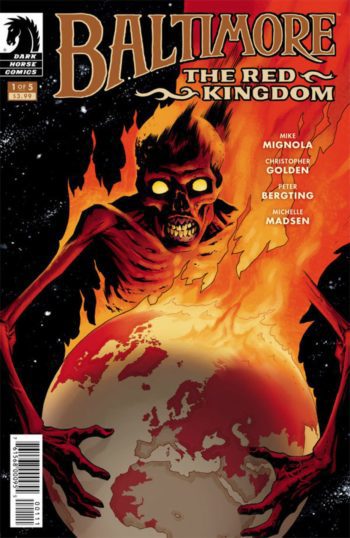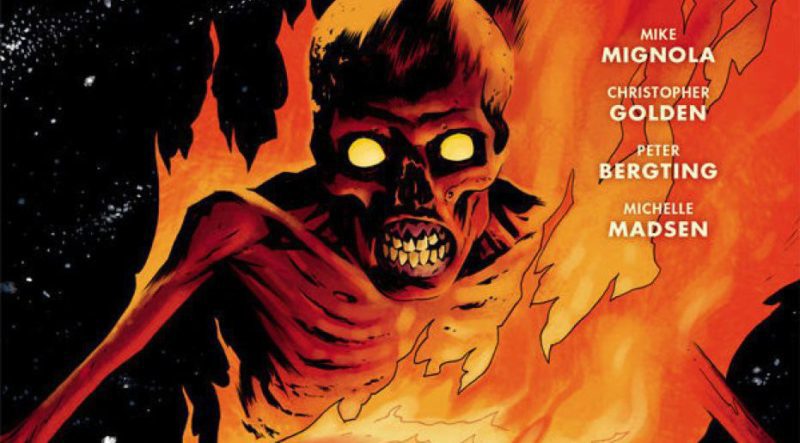INTERVIEW: ‘Baltimore’ story comes to bittersweet end with ‘The Red Kingdom’

Christopher Golden and Mike Mignola are saying goodbye to their comic-book creation Baltimore. Their five-part conclusion is called The Red Kingdom, and for Golden, bidding adieu is bittersweet. In many ways, Baltimore was the story that kept on giving and taking varied turns into new creative passageways.
The Baltimore series, which has now been compiled in several graphic novels, follows a vampire hunter by the name of Lord Baltimore. His nemesis is the Red King, billed as evil incarnate by Dark Horse, Baltimore’s publisher. In the newest graphic novel, the Red King dominates, and Lord Baltimore is missing. As the world teeters on the brink of being lost forever, Baltimore needs to make one last stand and avenge the death of his family.
Fans have followed Lord Baltimore’s tribulations in many forms. From The Cult of the Red King to The Plague Ships and The Curse Bells, the dark, horror-filled adventures have kept readers both terrified and engaged over the years. Now, with The Red Kingdom, the story comes to a final battle — one for the ages.
Other collaborators this time include Peter Bergting and Michelle Madsen.
Recently, Hollywood Soapbox exchanged emails with Golden about the conclusion of the series. Questions and answers have been slightly edited for style.
Is releasing Baltimore: The Red Kingdom bittersweet because it’s the end of a series and set of characters that have been around for a number of years? Or is this not the “epic conclusion” as Dark Horse put it?
Oh, Dark Horse’s description is spot on. As for bittersweet, absolutely. I’ve been with these characters in one form or another — the novel, the screenplay and 41 issues of the comics series. Forty-one issues, and it feels more like 10 in my memory. But I can’t stand comics series that drag on for no other reason than to keep the issues coming. Once I knew the ending, knew how it would all unfold, that was the story that was going to be told. There are conversations happening on other fronts and still some secrets left that I think readers will really appreciate, but to say any more than that would be to spoil them. But yes, this is the conclusion, and yes, I’m going to miss the hell out of this series and these characters.
How planned out was the entire series from the time of the illustrated novel? Did you keep writing stories only after seeing there was an audience?
Honestly, the audience never factored into it, aside from our being deeply appreciative of the way fans embraced these characters. When Mike and I did the novel, we’d talked about a sequel and the possibility of comics. There was this big gap in Baltimore’s story (in the novel), years of stories to be told, and we honestly could have spent 200 issues covering Baltimore’s adventures fighting monsters during that five year gap. But again, creating issue after issue is not the same as telling the story of your character. I respect long-running comics and characters for what they do, but it’s a different type of storytelling. And there’s a reason different creative teams cycle in and out of them and why reboots happen so frequently.
When I was writing the screenplay for the then-planned New Regency film version of Baltimore, we started talking about the comics more in depth, and that led to one long conversation in which we planned out the majority of what would become the four three volumes of Baltimore, the comics series. Volume five was cleaning up some unfinished business, having some fun, and putting all of the pieces in place for the rest of the series … even though we didn’t yet know what form the rest of it would take. I’m pretty sure it was while I was outlining volume six, The Cult of the Red King, that the rest of it came to me. I called Mike, hoping he’d embrace what I wanted to do for the last three — six, seven, and this final volume — and fortunately he was very enthusiastic about it.
What’s it like to create in a collaboration with Mike Mignola?
It’s changed over the years. I’ve known Mike since just after the first issue of Hellboy was published. I’ve written three Hellboy novels, edited about half a dozen others and four prose anthologies. We’ve done three novels together and two comics series — Baltimore and Joe Golem: Occult Detective. I co-wrote the first BPRD miniseries with Tom Sniegoski. I’ve written two screenplays connected to my work with Mike, one for Baltimore and one other that I’m not supposed to talk about. Almost every one of those experiences has had a different basic composition.
Here’s what I will say. Mike and I share a certain frame of reference, and we’ve been friends for more than 20 years. We both love folklore and characters who are carrying a certain weight on their shoulders. Over the years, I’ve become pretty familiar with Mike’s interests and pet peeves, story-wise. But always, always, the best thing about working with him is the freedom of imagination that he inspires. Almost nothing is too crazy to consider or too weird to take seriously. I love that.
How do you think the final five-part series stacks up against the previous issues? It seems The Red Kingdom is quite dark and foreboding given the Red King’s rise and Baltimore’s missing whereabouts.
Pretty sure the whole thing is dark and foreboding, so that should come as no surprise. I’ve been incredibly fortunate to work with incredible art talent on this series, and that includes the best color artists in the business. People will decide for themselves, but to me, The Red Kingdom is a worthy ending. It’s the ending I wanted and the ending Mike wanted, and it made our fantastic artist, Peter Bergting, cry. So we’ve got that going for us. Heh heh.
Although you’ve branched out as the series progressed, was it difficult to find original angles to the “vampire tale”?
We never thought of it as a vampire story. Yes, the novel and the first few volumes are FULL of vampires, and Baltimore’s nemesis in the first half of the series, Haigus, is a vampire. But it was always both bigger and smaller than that. Bigger in the sense of the larger threat, the cosmic battle. Smaller in the sense that it’s always been about Baltimore and those in his circle, about intimate questions of life and death and human purpose. Ugh. ‘Human purpose. That sounds like a literature professor talking, but it’s true. As for originality … Mike had some specific things he wanted to do and not do in the novel, and that set us up to do some very original things with vampires. Ironically, some of those ‘original’ things are really very old things that seem original because nobody remembers them anymore.
What’s up next for you?
My novel Ararat will be out in April from St. Martin’s Press. It concerns Noah’s Ark and an ancient cadaver with horns, and it’s in development for film at the moment. I’m also developing my novel Snowblind as a television series with Blumhouse. Comics-wise, more with Dark Horse, but I don’t think I’m allowed to talk about it yet.
By John Soltes / Publisher / John@HollywoodSoapbox.com
Issues of Baltimore: The Red Kingdom are currently available from Dark Horse. Click here for more information.

